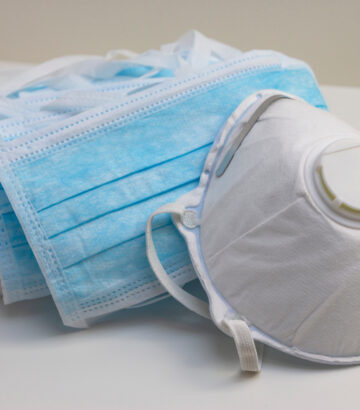WHN Response to Canada’s CSA Z94.4-25 Respirator Standard
CSA Z94.4-25 is a draft national standard proposing science-based airborne protection measures, including universal respirator use in healthcare. While broadly welcomed, it has also drawn a petition in opposition. WHN supports the standard and rejects the petition’s claims.
Canada’s national standards body, the Canadian Standards Association (CSA), has released a public draft of CSA Z94.4-25: Selection, Use, and Care of Respirators. This standard reflects decades of science and applies airborne transmission risk assessment consistently across all workplaces, including healthcare. WHN has released the following statements to support the standard and respond to the petition in opposition.
WHN Statement in Support of CSA Z94.4-25
CSA Z94.4-25 represents a long-overdue shift toward protecting healthcare workers and other professionals from airborne hazards. It incorporates modern scientific understanding, including the Source-Pathway-Receiver model, and offers a practical, scalable approach to implementing respiratory protection programs.
Read the full WHN Support Statement (PDF)
Summary of Healthcare Requirements (CSA Z94.4-25):
- Universal respirator use in healthcare, unless a space is shown by risk assessment to be exempt.
- Minimum of PL1 protection (e.g., N95 or equivalent) in routine care.
- Specific programmatic requirements: fit testing, training, access, and environmental guidance.
- Surgical masks are not recognized as respiratory protection.
Read full summary of healthcare-specific CSA requirements (PDF)
WHN Statement Opposing the Petition
A petition opposing CSA Z94.4-25 has been circulated by individuals aligned with traditional infection prevention frameworks. WHN strongly opposes the petition, which:
- Misrepresents the content of the CSA draft;
- Fails to engage with the scientific rationale;
- Lacks input from experts in airborne hazard prevention;
- Undermines trust in transparent, multi-stakeholder standards development.
Read the WHN Statement Opposing the Petition (PDF)
How You Can Take Action
CSA is accepting public comments on the draft Z94.4-25 standard through August 19, 2025.
Access the CSA Z94.4-25 Draft and Submit a Comment (registration required)
Public Review comments are open to everyone who registers.
Canadian Standards Association (CSA) calls for universal respirator use in healthcare settings and for patient care outside of healthcare settings (e.g., homecare).
How you can help: Submit positive, constructive comments through CSA’s official portal. This is a unique opportunity to ensure science-based, precautionary protection becomes national policy.
Use WHN Template Letters to Engage Institutions (PDF) or Colleagues (PDF)
Need help writing a comment? See instructions and sample statements.
More helpful information from Do No Harm BC.
Reference Materials
- WHN Statement in Support of CSA Z94.4-25 (PDF)
- WHN Statement Opposing the Petition (PDF)
- WHN Template Letter to Key Hospital Individuals (Google Doc, Word Document, PDF)
- WHN Template Letter to Allies (Google Doc, Word Document, PDF)
- CSA Draft Summary: Healthcare Respirator Requirements (PDF)
- Commentary: Response to the Petition Opposing CSA Z94.4-25 (PDF)
- Instructions for Commenting on CSA Z94.4
- Sample Statements for Commenting on CSA Z94.4-25
- Do No Harm BC
Statement by the World Health Network in Support of the CSA Z94.4-25 Respiratory Protection Standard
The World Health Network (WHN) supports the draft CSA Z94.4-25 standard, which establishes a science-based framework for the selection, use, and care of respirators across workplaces, including healthcare. This standard reflects up-to-date evidence on airborne hazards and lays the foundation for protecting workers, patients, and the public from avoidable harm.
Grounded in Science and Risk Assessment
The CSA standard incorporates a rigorous and comprehensive hazard identification and risk analysis framework, as outlined in Chapter 7 of the draft. It applies the Source-Pathway-Receiver model to assess risk of bioaerosol exposure and provides detailed criteria for evaluating workplace hazards, exposure scenarios, and appropriate respiratory protection. These procedures are consistent with best practices in occupational health and infection prevention, and align with international scientific consensus on airborne transmission of infectious agents【27†Chapter 7.docx†L1-L10】.
Notably, the CSA standard:
- Recognizes that airborne infectious diseases pose serious risks in both healthcare and non-healthcare workplaces;
- Emphasizes engineering and administrative controls first, with respirators as a necessary protective measure when such controls are insufficient;
- Provides clear guidance on assessing microbial hazard levels (H1 to H4) and the appropriate level of respiratory protection (PL1 to PL4) to be used in each case【27†Chapter 7.docx†L100-L120】;
- Incorporates the precautionary principle and allows for context-sensitive judgment by qualified professionals in the risks of airborne transmission.
Universal Respiratory Protection in Healthcare: A Necessary Advancement
The CSA’s guidance for healthcare settings, detailed in Chapter 9, is both pragmatic and urgently needed. It establishes that all healthcare workers must wear respirators (minimum PL1) in healthcare facilities and during delivery of care, except in designated low-risk zones determined by qualified airborne transmission risk assessment. This requirement is grounded in:
- The elevated baseline risk of airborne infectious exposure in healthcare settings;
- The evidence that surgical masks are insufficient to protect against bioaerosols;
- The ethical imperative to prevent healthcare-acquired infections (HAIs), protect workers, and limit broader public transmission【28†Chapter 9.docx†L1-L20】.
By incorporating design flexibility (e.g., reusable respirators, easy-breathing CA-N95 options) and allowing for institution-specific airborne transmission risk management plans, the standard provides a scalable, adaptable path to implementation.
A Standard That Extends Across Workplaces
CSA Z94.4-25 does not treat healthcare as an isolated domain. Instead, it presents a coherent, cross-sectoral strategy that applies the same scientific principles to all workplaces, from healthcare to manufacturing, agriculture, education, and transportation. This reflects the biological reality of airborne particle behavior and transmission: pathogens do not respect workplace boundaries.
This integrated approach is especially important for pandemic and inter-pandemic preparedness. It ensures that Canada has a robust, scalable respiratory protection standard that can adapt to future infectious threats.
Conclusion
We commend the CSA for developing a transparent, science based standard that addresses longstanding gaps in respiratory protection. We urge regulators, health authorities, employers, and professional societies to adopt and implement this standard in full.
The World Health Network is committed to supporting public understanding and institutional adoption of CSA Z94.4-25. We invite other organizations, health professionals, and workers to join us in endorsing this standard as a vital tool for workplace safety and public health.
Statement by the World Health Network Opposing the Petition Against CSA Z94.4-25
In Defense of Science-Based Workplace Protections: Why the Petition Against CSA Z94.4-25 Must Be Rejected
A petition is being circulated in opposition to CSA Z94.4-25, the new standard that sets rigorous, science-based guidelines for respiratory protection in workplaces, especially healthcare. The World Health Network (WHN) strongly opposes this petition. It is misleading, misinformed, and poses a threat to the health and safety of healthcare workers, patients, and the public.
1. CSA Z94.4-25 Reflects Modern Airborne Science
CSA Z94.4-25 is the product of a transparent, interdisciplinary process grounded in the science of airborne transmission and exposure control. It incorporates the Source-Pathway-Receiver model and a tiered hazard classification framework (H1–H4) to determine appropriate levels of protection (PL1–PL4). These principles are drawn from current aerosol science, infection control, engineering, and occupational health.
The standard does not propose a one-size-fits-all solution. Instead, it provides a structured risk assessment framework and scalable requirements tailored to specific hazards. It emphasizes engineering and administrative controls first – with respirators as a critical last line of defense when these controls are insufficient.
2. The Petition Ignores the Science – and Fails to Engage With the Standard
The petition opposing CSA Z94.4-25 does not engage with the scientific basis of the standard itself. It makes assertions about burden and feasibility, but provides no evidence-based rebuttal to the risk modeling, exposure pathways, or control strategies that form the heart of the CSA standard.
This omission is especially significant because CSA Z94.4-25 draws on detailed assessments in Chapters 7 and 8, which outline how bioaerosols are generated, transmitted, and mitigated. The petition’s failure to address any of these elements raises concerns about the signers’ familiarity with the scientific foundations of airborne hazard prevention.
We believe that any credible critique of this standard must begin with an understanding of the science it is based on. The petition offers none – and in doing so, risks undermining both public trust and professional credibility.
3. Qualifications Matter in Evaluating Standards
CSA Z94.4-25 addresses airborne hazards – a domain that demands specialized expertise. While the petition is signed primarily by professionals trained in traditional infection prevention models, most do not hold qualifications in airborne exposure science, aerosol behavior, or respiratory protection.
Public positions on airborne respiratory protection – whether supportive or critical – will naturally be viewed through the lens of professional qualifications in this domain. Those who choose to oppose this standard without grounding in the science of airborne transmission should expect their judgment to be scrutinized accordingly.
4. The Standard Protects Healthcare Workers and Beyond
CSA Z94.4-25 rightly recognizes that airborne exposure risk in healthcare settings is substantial and persistent. The standard requires healthcare workers to wear respirators (minimum PL1) in clinical settings and during care delivery, except in designated low-risk zones determined by qualified airborne transmission risk assessment. This protects not only workers but also patients and institutional integrity.
By incorporating design flexibility (e.g., reusable respirators, easy-breathing CA-N95 options) and allowing for institution-specific airborne transmission risk management plans, the standard provides a scalable, adaptable path to implementation.
Importantly, CSA Z94.4-25 applies the same principles across industries, consistent with how airborne particles behave – which apply regardless of domain. This is a strength, not a weakness: pathogens do not conform to organizational boundaries.
5. WHN’s Position
We commend the CSA for developing a transparent, science-based standard that addresses longstanding gaps in airborne respiratory protection. We call on regulators, employers, health systems, and professional societies to reject the petition and move forward with full implementation of CSA Z94.4-25.
We welcome dialogue – but it must begin with an understanding of airborne transmission, and a shared commitment to protecting everyone at risk.
Signed, The World Health Network
Letter to Key Hospital Individuals (Template)
Subject: Supporting CSA Z94.4-25: Aligning Respiratory Protection with Airborne Science
Dear Dr. [Last Name],
I’m writing on behalf of the World Health Network (WHN), an international alliance of scientists, physicians, engineers, and policy professionals working to advance public health through science-based policy and practice. We wish to commend your institution’s leadership in healthcare delivery and research – and to invite your engagement on a matter of urgent importance to healthcare worker and patient safety.
As you may know, CSA has released a draft revision of the Z94.4 respiratory protection standard. This new version, CSA Z94.4-25, integrates modern science on airborne transmission and provides a structured framework for respiratory protection across all workplaces — with dedicated guidance for healthcare environments.
We are concerned, however, by a petition that has been circulated in opposition to this standard. The petition fails to engage with the scientific foundation of the CSA process and overlooks both the established risks of airborne transmission and the growing consensus on the need for improved respiratory protection.
We respectfully share with you our formal statement opposing the petition and strongly supporting CSA Z94.4-25. We believe this standard:
- Reflects state-of-the-art understanding of airborne hazards and aerosol science;
- Aligns with occupational health principles across healthcare and non-healthcare settings;
- Provides scalable, practical pathways to implementation – including institution-specific airborne risk management plans and options for CA-N95 and reusable respirators;
- Is urgently needed to close longstanding gaps in worker and patient protection.
We welcome the opportunity to speak with your team about the standard’s content, rationale, and implications. We are also available to support discussions of implementation strategy or public engagement.
You can view our statement of support and response to the petition here (PDF).
Thank you for your leadership. We believe that institutions like [Institution Name] are well-positioned to help lead Canada into a future of safer, more resilient healthcare environments.
With respect and collaboration,
[Your Name]
on behalf of the World Health Network
Letter to Allies (Template)
Subject: Invitation to Support CSA Z94.4-25 and Defend Airborne Protection Standards in Canada
Dear [Name],
I’m writing on behalf of the World Health Network (WHN), a global alliance of scientists, physicians, engineers, and public health advocates working to advance science-based policy and protect public health. We are reaching out to invite your support for an urgent effort to defend a critical workplace safety standard under attack.
The Canadian Standards Association (CSA) has released draft standard Z94.4-25, which modernizes respiratory protection guidance based on the latest science of airborne transmission. The standard applies a structured, risk-based approach across industries, with specific guidance for healthcare settings. We believe it is a landmark document that has the potential to prevent avoidable harm, protect healthcare workers, and strengthen institutional readiness across Canada.
Unfortunately, a petition has been circulated in opposition to this standard. The petition misrepresents the content of the standard, does not engage with its scientific foundations, and reflects a long-standing resistance to acknowledging airborne transmission as a primary mode of infection. If successful, it would undermine a rare example of forward-looking, evidence-based policy in healthcare and occupational health.
We have prepared a formal statement in support of CSA Z94.4-25 and in opposition to the petition. We are inviting respected Canadian professionals, scientists, clinicians, and labor leaders to join us in endorsing the standard – and, if you’re willing, to consider co-signing or speaking out publicly.
You can view the current draft of our statement here (PDF).
If you are open to a conversation or would like more background before engaging, we would be glad to speak with you. Whether through public endorsement, private support, or institutional alignment, your voice could help shift this conversation back to science and safety.
With respect and appreciation,
[Your Name]
on behalf of the World Health Network
Summary: What CSA Z94.4-25 Requires in Healthcare Settings
(Based on draft content; final text may evolve through the CSA public review process)
📌 Universal Respirator Requirement
- All healthcare workers (HCWs) must wear respirators at all times in healthcare facilities and during delivery of healthcare services, except in exempted zones determined by documented risk assessment.
- Applies to:
- Hospitals and clinics
- Long-term care
- Ambulance and emergency services
- Home care and any setting where healthcare procedures are performed
📌 Minimum Protection Standard
- The default requirement is a Protection Level 1 (PL1) respirator:
- Includes filtering facepiece respirators (e.g., N95) or elastomeric half-face respirators with appropriate filters.
- If exposure to a Hazard Level 4 microorganism is likely (e.g., Ebola), a PL4 respirator is required — such as a powered air-purifying respirator (PAPR) with APF 1000.
📌 Exemptions and Risk Analysis
- Respirator use may be waived only where a qualified airborne transmission risk assessment finds negligible risk of harm.
- Exempted zones must be engineered to maintain air contamination below 5 CFU/m³ — through measures such as:
- Upper-room UV disinfection
- Displacement ventilation
- Exhaust systems or physical layout features
📌 Program and Training Requirements
Healthcare facilities must:
- Appoint a Qualified Person to manage the Respiratory Protection Program (RPP)
- Provide:
- Training, fit testing, and seal-check instruction
- A variety of respirator types and sizes for user comfort and fit
- Free access to respirators at all relevant care areas
- Encourage reusable respirators and promote environmental responsibility through the 3Rs:
- Reduce, reuse, recycle
📌 Surgical Masks
- Surgical masks are not considered respiratory protection and may not be used by HCWs for respiratory hazards.
- They may be worn by patients as source control in cases where respirators are not feasible.
Commentary: Response to the Petition Opposing CSA Z94.4-25
The standard is clear, science-based, and long overdue.
By Barry Hunt and Richard Dixon, CHAIR (Coalition for Community and Healthcare Acquired Infection Reduction) https://chaircoalition.org
The petition opposing CSA Z94.4-25 contains serious misrepresentations. As experts familiar with both the CSA process and respiratory protection science, we offer the following clarifications to help set the record straight.
The CSA Standard Is Evidence-Based and Clear
- The CSA Z94.4-25 standard is thoroughly evidence-based, with references included throughout.
- It reflects a paradigm shift: the new default is to protect healthcare workers (HCWs) unless safety without protection can be clearly demonstrated – not the outdated default of leaving HCWs unprotected.
- Risk analysis now determines where respiratory protection can be waived, not where it must be justified.
- Modes of transmission are accurately classified, with airborne transmission recognized as the predominant mode for many pathogens, including SARS-CoV-2.
What the Standard Does Not Say
Contrary to claims in the petition:
- It does not claim that all antimicrobial resistant organisms are airborne.
- It does not require respirators for non-pathogenic organisms. In fact, it explicitly defines protection levels:
- RG1 (non-pathogenic): No respiratory protection required
- RG2 & RG3: N95 or equivalent
- RG4: PAPR with APF 1000
- There is no confusion in the document – the protection logic is clear, practical, and science-based.
The CSA Process Is Transparent and Balanced
- The CSA standard committee follows a transparent and inclusive process. Committees are composed of a balanced matrix of stakeholder interests, and all author affiliations are disclosed.
- There were dozens of healthcare representatives engaged over two years. Some chose not to participate, but those who did were overwhelmingly supportive.
- Contrary to suggestions of bias, there is no commercial conflict of interest:
- “Producer Interest” (e.g. manufacturers) is a required category, but in this case was underrepresented with only one manufacturer (3M) present on the committee.
- Disclosure – Barry Hunt, Co-Founder and Executive Director of CHAIR, is a CSA Z94.4 Committee member, former respirator producer, and provides unpaid voluntary guidance to the Canadian Association of PPE Manufacturers (CAPPEM).
Respirator Use ≠ Commercial Windfall
- There is no commercial “pot of gold” from adopting this standard.
- Major manufacturers like 3M and Medicom already have long-term contracts (up to 10 years) in place with provincial and federal governments.
- Healthcare systems in Canada are overstocked with respirators. If not used, they will be landfilled or recycled when they expire.
- Implementing this standard would prevent waste, not create it.
A Moment to Build Trust, Not Undermine It
- Adopting CSA Z94.4-25 would increase trust in healthcare, not erode it.
- The standard provides clarity, consistency, and science-aligned policy to protect workers and patients alike.
Final Thought
Opposition to increased respiratory protection in healthcare when one-third of respiratory disease in hospitals (Flu, RSV, and COVID) is caused by the hospital itself is the antithesis of precautionary, protective, or scientific in nature.
The CSA committee has done commendable work. At this point, it’s imperative they receive support to see this standard through. We have an opportunity in Canada to move beyond outdated paradigms to align healthcare worker and patient protection with the care, concern, science and ethics people deserve and the sustainability our healthcare system needs.
Instructions for Commenting on CSA Z94.4
- Access the CSA Z94.4-25 Draft and Submit a Comment (registration required)
https://publicreview.csa.ca/Home/View/2256677 - Click “Log in” to create login credentials (register or sign in).
- Fill out your registration information.
- Use the search bar to search Z94.4 or click on the section labeled “Occupational Health and Safety.”
- If you click into “Occupational Health and Safety” find Z94.4 (Selection, Use, and Care of Respirators) and click on that.
- Click “Read Draft.”
- You can click on any section to view public comments and make comments. Comments can be made in any section.
- You can denote your comments as they pertain to comment type (general, editorial, or technical), and propose changes. If no changes are proposed you can write “no correction needed.” You can also mark that your comments or suggestions are being made on behalf of an organization you are affiliated with.
Sample Statements for Commenting on CSA Z94.4-25
🔹 Core Endorsement
- I strongly support the CSA Z94.4.25:2025 standard as a critical and long-overdue update that reflects current scientific understanding of airborne transmission and occupational safety.
- This standard will protect health care workers, patients, and the public by finally aligning policy with what science has made clear for years.
🔹 Clean Indoor Air and Respiratory Protection
- This standard is a historic step forward—a Semmelweisian moment in public health—by recognizing that clean indoor air and respirator use are essential to infection control.
- Fit-tested respirators, not surgical masks, are the appropriate protection against airborne pathogens. This standard rightly includes them as central to respiratory protection programs.
- By addressing airborne transmission, this standard will help ensure that health care settings are safe and accessible for all—especially those at higher risk due to age, disability, or immunocompromise.
🔹 Precautionary Principle
- In health care settings, where the risk of exposure is constant and the stakes are high, the precautionary principle must be the default.
- The tools to prevent harm from airborne diseases—respirators, ventilation, and clean air—are available and effective.
- This standard wisely puts prevention first, rather than repeating past delays that have cost lives.
🔹 COVID-19 Is Not Just a Respiratory Illness
- COVID-19 is not a respiratory infection. It is a vascular, multi-system disease with serious and lasting consequences.
- Grouping it with other respiratory viruses like flu or RSV fails to account for its distinct severity and long-term harms.
- Standards should continue to treat COVID-19 as a unique and ongoing threat that requires effective airborne precautions.
🔹 Long COVID Is a Public Health Crisis
- Long COVID is already disabling many millions of people worldwide, including a significant number of health care workers.
- Any credible respiratory protection standard must address the long-term consequences of infection, not just short-term outcomes.
- By reducing infections in health care settings, this standard also reduces the incidence of Long COVID—a crucial public health goal.
🔹 Clarity on Respirators vs. Surgical Masks
- CSA should be applauded for clearly distinguishing between respirators and surgical masks.
- Surgical masks are not designed or sufficient for airborne transmission. This must remain clear and unambiguous in both the final standard and supporting communications.
- Maintaining this clarity will help avoid confusion and ensure proper implementation across health care settings.
🔹 Why It Matters Now
- Canada has the opportunity to lead globally with this science-based approach to health care safety. Let’s not miss this moment.
- This standard represents a chance to fix long-standing failures in health care safety and infection prevention.
- It will save lives, reduce disability, protect the workforce, and restore public trust in the health care system.











